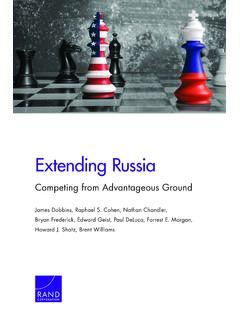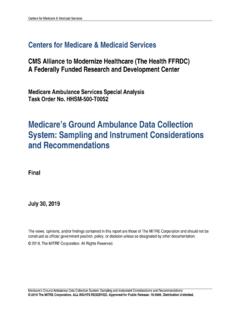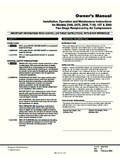Transcription of Valid and Reliable Assessments - ed
1 Valid and Reliable AssessmentsDetermining whether an assessment is Valid and Reliable is a technical process that goes well beyond making sure that test questions focus on material covered in state standards. While both of these terms are used by researchers in association with precise statistical procedures, this brief will define assessment validity and reliability in a more general context for educators and is a measure of consistency. It is the degree to which student results are the same when they take the same test on different occasions, when different scorers score the same item or task, and when different but equivalent tests are taken at the same time or at different times.
2 Reliability is about making sure that different test forms in a single administration are equivalent; that retests of a given test are equivalent to the original test, and that test difficulty remains constant year to year. When a student must take a make-up test, for example, the test should be approximately as difficult as the original test. There are many such informal assessment examples where reliability is a desired trait. The main difference is how it is tracked. For informal Assessments , professional judgment is often called upon; for large-scale Assessments , reliability is tracked and demonstrated statistically.
3 Whether it is high-stakes Assessments measuring end-of-course achievement, or Assessments that measure growth, reliability is critical for any assessment that will be used to make decisions about the educational paths and opportunities of students. Types of evidence for evaluating reliability may include: Consistent score meanings over time, within years, and across student groups and delivery mechanisms, such as internal consistency statistics ( , Cronbach s alpha) Evidence of the precision of the Assessments at cut scores, such as reports of standard errors of measurement (the standard deviation of errors of measurement that are associated with test scores from a particular group of students)
4 Evidence of the consistency of student level classification, such as reports of the accuracy of categorical decisions over time (reliability analyses [ , overall, by sub-group, by reportable category])CSAI UpdateMarch 2018 Valid and Reliable AssessmentsCSAI Update Evidence of the generalizability of results, including variability of groups, internal consistency of item responses, variability among schools, consistency between forms, and inter-rater consistency in scoring, such as a discussion of reliability in the technical report for the state s assessments1 Reliability is expressed mathematically on a scale from zero to one, with one representing the highest possible reliability.
5 Multiple choice and selected response items and Assessments tend to have higher reliability than constructed responses and other open-ended item or assessment types, such as alternate Assessments and performance tasks, since there is less scoring interpretation Since reliability is a trait achieved through statistical analysis, it requires a process called equating, which involves statistically adjusting scores on different forms of the same test to compensate for differences in difficulty (usually fairly small differences). Equating makes it possible to report scaled scores that are comparable across different forms of a test.
6 ValidityOne question that is often asked when talking about Assessments is, Is the test Valid ? The definition of validity can be summarized as how well a test measures what it is supposed to measure. Valid Assessments produce data that can be used to inform education decisions at multiple levels, from school improvement and effectiveness to teacher evaluation to individual student gains and performance. However, validity is not a property of the test itself; rather, validity is the degree to which certain conclusions drawn from the test results can be considered appropriate and meaningful.
7 3 The validation process includes the assembling of evidence to support the use and interpretation of test scores based on the concepts the test is designed to measure, known as constructs. If a test does not measure all the skills within a construct, the conclusions drawn from the test results may not reflect the student s knowledge accurately and thus, pose a threat to validity. To be considered Valid , an assessment should be a good representation of the knowledge and skills it intends to measure, and to maintain that validity for a wide range of learners, it should also be both accurate in evaluating students abilities and Reliable across testing contexts and scorers.
8 4 Types of evidence for evaluating validity may include: Evidence of alignment, such as a report from a technically sound independent alignment study documenting alignment between the assessment and its test blueprint, and between the blueprint and the state s standards Evidence of the validity of using results from the Assessments for their primary purposes, such as a discussion of validity in a technical report that states the purposes of the Assessments , intended interpretations, and uses of results Evidence that scores are related to external variables as expected.
9 Such as reports of analyses that demonstrate positive correlations with 1) external Assessments that measure similar constructs, 2) teacher judgments of student readiness, or 3) academic characteristics of test takers1 CCSSO. (2013). Criteria for procuring and evaluating high-quality Assessments . Washington, DC: Author. Retrieved March 16, 2018 from RAND Corporation. (1997). Criteria for comparing Assessments : Quality and feasibility. In Using alternative Assessments in vocational education. Retrieved March 16, 2018 from Caffrey, E. (2009). assessment in elementary and secondary education: A primer.
10 Congressional Research Service. Retrieved March 16, 2018 from Darling-Hammond, L., Herman, J., Pellegrino, J., et al. (2013). Criteria for high-quality assessment . Stanford, CA: Stanford Center for Opportunity Policy in and Reliable AssessmentsCSAI UpdateCSAI Update is produced by the The Center on Standards and assessment Imple-mentation (CSAI). CSAI, a collaboration between WestEd and CRESST, provides state education agencies (SEAs) and Regional Comprehensive Centers (RCCs) with research support, technical assistance, tools, and other resources to help inform decisions about standards, assessment , and accountability.

















